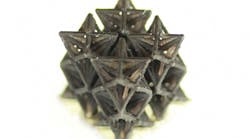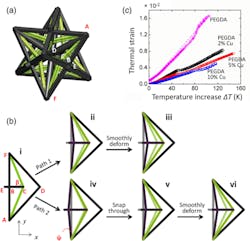A team of scientists from the University of California, Lawrence Livermore National Labs (LLNL), Massachusetts Institute of Technology (MIT), and other institutions present a metamaterial that exhibits minimal thermal shrinking when exposed to temperatures as high as 540°F. Although it is made of two thermally expanding materials, the star-shaped unit cells of the metamaterial have a mechanical design that promotes negative thermal expansion (NTE) when subjected to heat. The results are published in Physical Review Letters Journal.
The research was conducted under a 5-year Defense Sciences Offices program funded by DARPA. While structures for heat-shrinking metamaterials have been proposed before, the necessary tools to build them did not always exist. Scientists have been able to create NTE metamaterials that shrink in 2 dimensions using various crystal-engineering methods, but until now, have not been able to create one that shrinks in 3-dimensions. In the age of 3D printing micro-fabrication techniques, scientists are equipped to create individual unit cells with virtually any design, and exact dimensions can be read from a computational model. In addition, the stereolithography printer extrudes multiple materials and cures with a light source for simplicity.
The product created and designed in this project is classified as a metamaterial because its ingredients act separately to induce a behavior that would not occur naturally. The legs or trusses of each star-shaped unit cell are made of polymer and copper/polymer-composites with different thermal expansion rates. The scientists can control the extent of shrinking for the entire metamaterial by altering the relative lengths of each beam and their stiffness through their computer model.
Each star-shaped unit cell is made up of tetrahedral pyramids that point inward. The base of each tetrahedral does not contain beams around its perimeter; rather, the beams lie diagonally to form a cross with a node at the center of the base. The legs that make up the base of the tetrahedrals are a stiffer copper/polymer composite, shown in black. The intersection at the base is connected to the inner legs of the cells, which point inward and are made of the quick-to-expand polymer.
As the system is heated, the inner legs begin to expand, pulling upward on the beam that connects to the node of the tetrahedral base. As the inner legs pull the node in toward the center of the star, the structures begin to collapse on itself, causing the entire metamaterial to contract. To preserve the overall shape so the metamaterial can retract back to its original size, structural beams protrude in 3 dimensions from the center of the star.
Overall, the reported metamaterial shrinkage was just 0.06%. The scientists are still optimizing their model to reduce all shrinking to zero under intense heat for applications that may need to withstand high-heat cycling. These may include chips for computing and electronics, dental fillings, and structural and mechanical fillers.

